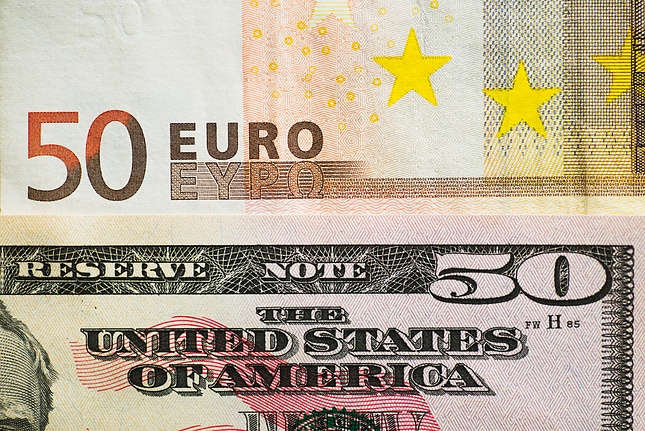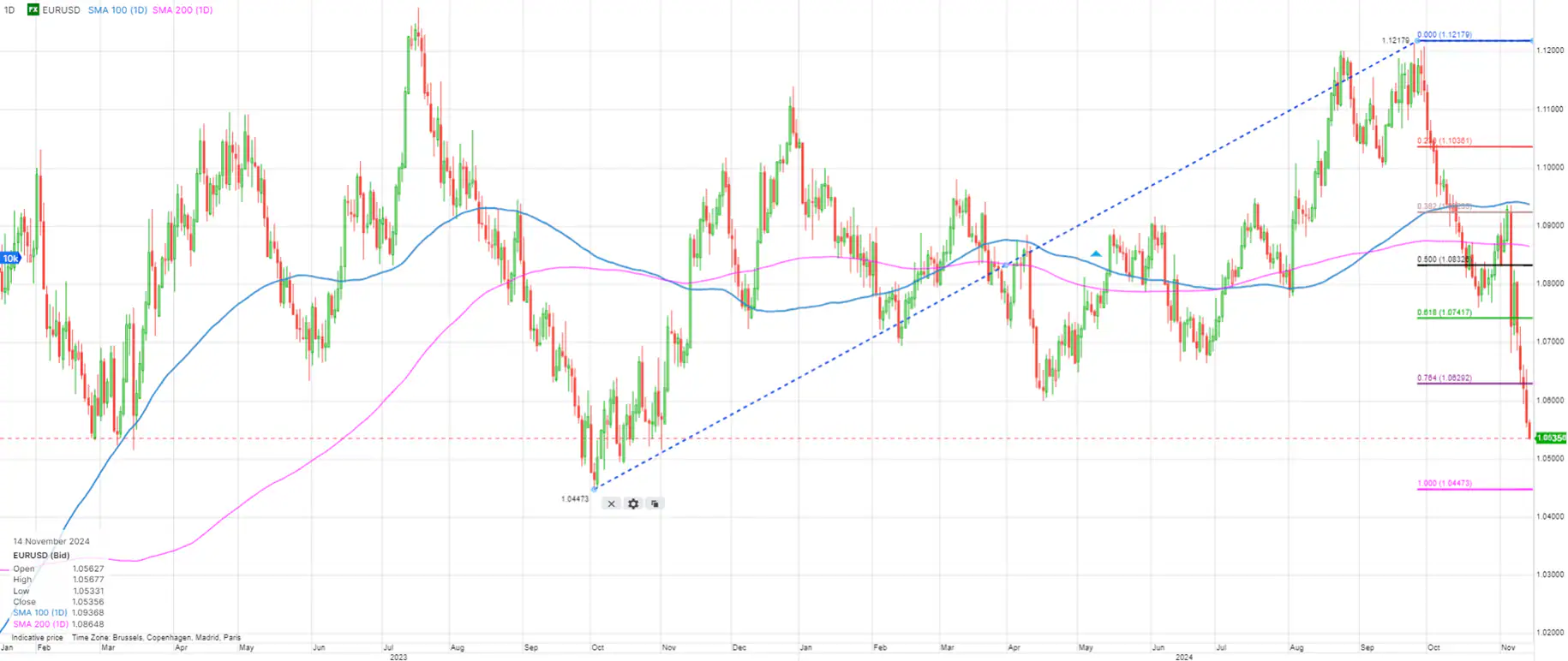The US dollar has climbed to multi-month highs again even as the Fed is on an easing path, benefiting from a variety of supporting factors that continue to propel its strength.
Key drivers for USD strength
Trump 2.0 tariffs policy: The administration’s renewed focus on tariffs could weigh heavily on currencies of trade-exposed economies, particularly those in Asia and the Eurozone. The appointment of China hawks to the cabinet is spelling a clear near-term focus on trade and tariff policy, which is USD-positive. The Chinese yuan (CNH), euro (EUR), Mexican peso (MXN), and Australian dollar (AUD) are among the most vulnerable to this trade pressure, as these regions face heightened risks from tariff wars.
Trump 2.0 fiscal policy: The fiscal push, including tax cuts and deregulation, is likely to support US growth, which could drive yields higher. Rising yields, particularly in the US, increase the relative appeal of the USD against lower-yielding currencies, further boosting demand for the dollar.
Fed easing from strength: While the Fed is cutting rates, it is doing so from a position of economic strength, with the US economy continuing to show resilience. This strength provides a solid foundation for the dollar, as markets see the Fed’s actions as a proactive measure rather than a response to economic weakness.
US exceptionalism: The continued political and economic challenges facing other major global players, particularly Europe and Japan, further bolster the USD. In Europe, political instability—especially in Germany where a ‘snap’ election will now be held next February – is adding to the economic malaise. Meanwhile, Japan’s delay in raising rates leaves the yen in a precarious position.
Geopolitical risks: Geopolitical tensions, particularly in the Middle East, have the potential to flare up at any moment, further supporting the dollar’s safe-haven status. In times of heightened global uncertainty, investors typically flock to the USD, increasing its demand.
Room for USD to run
Given these factors, the USD still has room to run. With the ongoing pressures on trade-exposed currencies, the US dollar is likely to remain a dominant force in global markets.
Most exposed
EUR: Political instability in Europe, combined with an already fragile economic recovery and the looming threat of tariffs, leaves the euro vulnerable.
CNH (Chinese yuan) and China-proxies like AUD: As the US-China trade war intensifies, the yuan faces increasing pressure, especially with China’s policy stance favoring further stimulus.
JPY: Carry trades could gain interest once again with Fed’s easing stance likely to be more cautious and BOJ’s hesitant on rate hikes under the new government. .
Commodities: Commodities are facing a double whammy—downward pressure on demand due to escalating trade frictions and a stronger US dollar. As tariffs hit global supply chains and trade volumes, the demand outlook for key commodities, such as industrial metals and oil, weakens. Additionally, a higher USD often makes commodities more expensive for holders of other currencies, further dampening global demand.
Least exposed
GBP: Sterling is less exposed to tariff-risks and an inflationary budget could slow down the pace of BoE rate cuts.
Read the original analysis: USD: How high can it go?
The Saxo Bank Group entities each provide execution-only service and access to Analysis permitting a person to view and/or use content available on or via the website. This content is not intended to and does not change or expand on the execution-only service. Such access and use are at all times subject to (i) The Terms of Use; (ii) Full Disclaimer; (iii) The Risk Warning; (iv) the Rules of Engagement and (v) Notices applying to Saxo News & Research and/or its content in addition (where relevant) to the terms governing the use of hyperlinks on the website of a member of the Saxo Bank Group by which access to Saxo News & Research is gained. Such content is therefore provided as no more than information. In particular no advice is intended to be provided or to be relied on as provided nor endorsed by any Saxo Bank Group entity; nor is it to be construed as solicitation or an incentive provided to subscribe for or sell or purchase any financial instrument. All trading or investments you make must be pursuant to your own unprompted and informed self-directed decision. As such no Saxo Bank Group entity will have or be liable for any losses that you may sustain as a result of any investment decision made in reliance on information which is available on Saxo News & Research or as a result of the use of the Saxo News & Research. Orders given and trades effected are deemed intended to be given or effected for the account of the customer with the Saxo Bank Group entity operating in the jurisdiction in which the customer resides and/or with whom the customer opened and maintains his/her trading account. Saxo News & Research does not contain (and should not be construed as containing) financial, investment, tax or trading advice or advice of any sort offered, recommended or endorsed by Saxo Bank Group and should not be construed as a record of our trading prices, or as an offer, incentive or solicitation for the subscription, sale or purchase in any financial instrument. To the extent that any content is construed as investment research, you must note and accept that the content was not intended to and has not been prepared in accordance with legal requirements designed to promote the independence of investment research and as such, would be considered as a marketing communication under relevant laws.
Recommended Content
Editors’ Picks

EUR/USD holds above 1.0450 German sentiment data
EUR/USD stays in positive territory above 1.0450 after retracing a portion of its bullish opening gap. The data from Germany showed that the IFO - Current Assessment Index declined to 84.3 in November from 85.7, while the Expectations Index edged lower to 87.2 from 87.3.

GBP/USD pulls back toward 1.2550 as US Dollar sell-off pauses
GBP/USD is falling back toward 1.2550 in the European session on Monday after opening with a bullish gap at the start of a new week. A pause in the US Dollar decline alongside the US Treasury bond yields weighs down on the pair. Speeches from BoE policymakers are eyed.

Gold price manages to hold above $2,650 amid sliding US bond yields
Gold price maintains its heavily offered tone through the early European session on Monday, albeit manages to hold above the $2,650 level and defend the 100-period Simple Moving Average (SMA) on the 4-hour chart. Scott Bessent's nomination as US Treasury Secretary clears a major point of uncertainty for markets.

Bitcoin consolidates after a new all-time high of $99,500
Bitcoin remains strong above $97,700 after reaching a record high of $99,588. At the same time, Ethereum edges closer to breaking its weekly resistance, signaling potential gains. Ripple holds steady at a critical support level, hinting at continued upward momentum.

Eurozone PMI sounds the alarm about growth once more
The composite PMI dropped from 50 to 48.1, once more stressing growth concerns for the eurozone. Hard data has actually come in better than expected recently – so ahead of the December meeting, the ECB has to figure out whether this is the PMI crying wolf or whether it should take this signal seriously. We think it’s the latter.

Best Forex Brokers with Low Spreads
VERIFIED Low spreads are crucial for reducing trading costs. Explore top Forex brokers offering competitive spreads and high leverage. Compare options for EUR/USD, GBP/USD, USD/JPY, and Gold.
